An Honorary Mennonite: Max Shtatsky
Werner Toews
In the early morning hours of February 14, 2024, I received a message through Facebook Messenger that stated, “Sorry for the terrible news . . . Max Shtatsky died in battle.”
The message was from Maxym Ostapenko, the former director of the Khortytsia National Reserve (KNR), located in Zaporizhzhia, Ukraine. Max Shtatsky was a senior research scientist at the KNR up until March of 2023, when he joined the Ukrainian military.
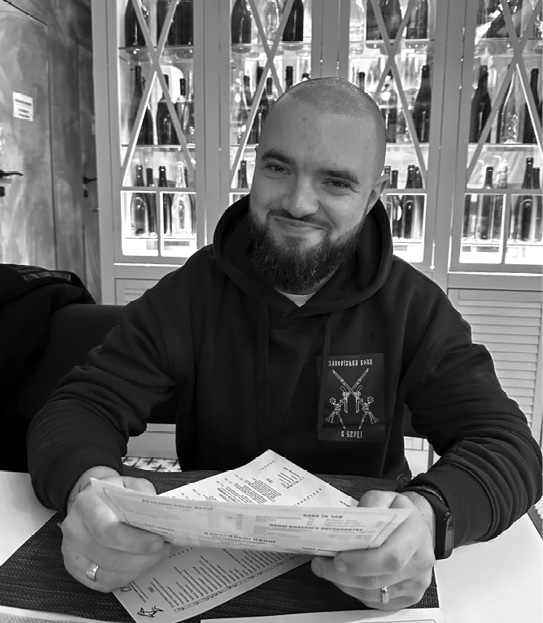
Max joined the military because he felt it was his duty to take part in the defence of Ukraine against the Russian invasion of February 2022. Just prior to his tragic death, he had been home on leave to visit his wife Darya, his young daughter Vasilisa, and his family.
Mennonite Connections
Who was this young Ukrainian historian and how did he become interested in Mennonite history? I came to know Max in 2017 through email correspondence. We shared an interest in the history of the Mennonites of Chortitza (Khortytsia) and the fate of the Mennonites during the height of the Great Terror in 1937–1938.
During our many conversations, he related that he was born and raised in Upper Chortitza, which was once was part of the village of Chortitza, and one of the first villages established by Mennonite settlers in 1789. The village and surrounding area are now a suburb of Zaporizhzhia.
His interest in studying and researching Mennonite history and the Mennonites who lived in the village of Chortitza started at an early age. Max recounted that during his childhood he observed several buildings in Upper Chortitza that did not fit into the Soviet style of architecture. Listening to stories from residents in his neighbourhood, he learned that in the past Upper Chortitza was home to a group of colonists that spoke German and had traditions that were foreign to him. He also discovered that in the 1930s the Soviet authorities had tried to erase the history of these colonists who called themselves Mennonites. His childhood curiosity would lead him to a career of studying and resurrecting the history of the Mennonites in Ukraine.
After completing high school, Max attended Zaporizhzhia National University, where he earned a degree in history. After receiving his degree, Max was hired by the Khortytsia National Reserve in 2010. In 2011, after attaining the position of research scientist, Max began conducting research on the history of the Mennonite colonists of Chortitza. It quickly became apparent to him that the Mennonites had made a significant contribution to Ukrainian culture, life, and agriculture. This revelation inspired Max to continue his research and uncover the past of the former inhabitants of Chortitza.
Chortitza Headstone Project
Over the next eight years, Max continued, along with his other duties at the KNR, to research and educate himself on Mennonite history. His research also included many field trips to Mennonite landmarks in Upper Chortitza and other historically significant locations in Zaporizhzhia.
All of his knowledge and education were put to use in July of 2019. During the 1970s and early 1980s a rumour had circulated through Upper Chortitza that a building in his neighbourhood contained gravestones from the former Chortitza Mennonite Church cemetery. The rumour was based on information from a local historian, who reported that late in the 1930s the Soviet authorities destroyed the Chortitza cemetery. What was not known was the fate of the gravestones from the cemetery. The destruction of the cemetery coincided with the construction of a barn in Upper Chortitza that was built at night. It was suggested at the time that the building was being constructed at night in order to conceal the use of gravestones from the cemetery as building materials.
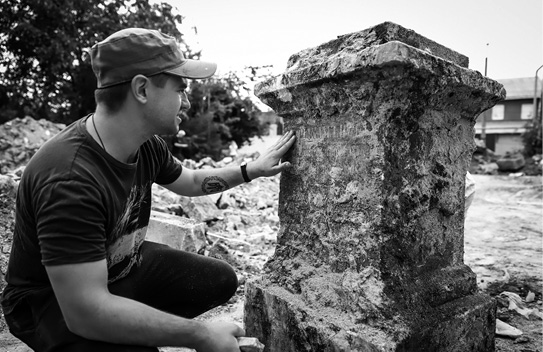
Years later, another local historian determined that this building was, in fact, located at 61-A Zachinyaeva Street in Upper Chortitza. This now abandoned and derelict building was situated in the heart of the former village of Chortitza on a lot once owned by Mennonite David Paetkau. Paetkau was killed by bandits on his property in 1919, during the unrest of the Russian Revolution. The remaining family members were forced from the property by the Soviet authorities in the early 1930s.
Max’s plan, years in the making, was to excavate the foundation of this building to either disprove or substantiate this rumour. It was his strong interest in Mennonite history that motivated him to embark on this ambitious project.
On the morning of July 22, 2019, Max, historian Roman Akbash, and Mykola Anatoliyovych Svydran, a colleague from the KNR, started the excavation of the building’s foundation. It was a hot and humid day, and they used only picks and shovels. It wasn’t long before the excavation led to the discovery of many gravestones belonging to the Chortitza Mennonites.
One of the first stones uncovered was a pedestal for a gravestone with no inscription. The second stone belonged to a woman with the maiden name of Siemens (1820–1887). It became quite clear from the start of the excavation that the stones had been cut or broken to create uniform building blocks for the foundation of the building. The top of the Siemens stone was missing and a search for the missing piece and other missing pieces of gravestones would continue throughout the excavation.
As the excavation progressed through July, Max uncovered many gravestones that had been used to construct the foundation of the building. It soon became quite clear that the entire foundation of the building was constructed with Mennonite gravestones and almost certainly from the Chortitza church cemetery.
The excavation continued through the fall, aided by heavy equipment, because of the weight of the stones and the length of the foundation walls of the building. The excavation was completed at the end of November 2019. By that point, over one hundred stones and pieces of gravestones had been excavated and transported to a KNR compound.
Max wrote, “People for over eighty years had passed by these gravestones and for the first time I could finally show them. For years I had dreamed of this project and now it is real. Hopefully we will find relatives of these unjustly forgotten people.”
In the ensuing weeks and months, news of the find spread through the city of Zaporizhzhia as well as to North American Mennonites through social media posts and online news reports. Max was now the spokesperson for the project, involved in promoting its next phase through media interviews and local news articles. He never tired of his extra duties, and continued with identifying and recording the names of the gravestones.
The next task for Max was to create a memorial with the newly discovered gravestones. This would require more hard work on his part. The work consisted of fundraising, finding a suitable location for the memorial, and hiring someone to restore the damaged gravestones.
Memorial and a Pandemic
In December 2019, a number of people with Mennonite ancestry, including historians and individuals representing various organizations, formed a group to assist Max and the Khortytsia National Reserve with the creation of a memorial utilizing a number of the gravestones. The group would also assist with fundraising and providing information about the Mennonites who had been buried in the Chortitza cemetery.
Max continued his work identifying the stones by sorting through the many pieces. This arduous work continued over the winter and into the spring of 2020. This took place despite the limitations caused by the worldwide Covid-19 pandemic. The initial list of gravestones that could be identified grew, and as of November 2020, contained 118 names.
Max’s find generated enormous interest from North American Mennonites. One historian remarked that the descendants of the people who had been buried in the Chortitza cemetery could be counted in the thousands, if not more. Social media posts by some of the descendants revealed many family connections to the gravestones.
After many discussions with Max and KNR director Maxym Ostapenko involving budget considerations, it was decided that fifteen stones would be cleaned and restored to create a memorial. After further discussions it was resolved that the memorial would be located on KNR property and would be monitored by KNR staff.
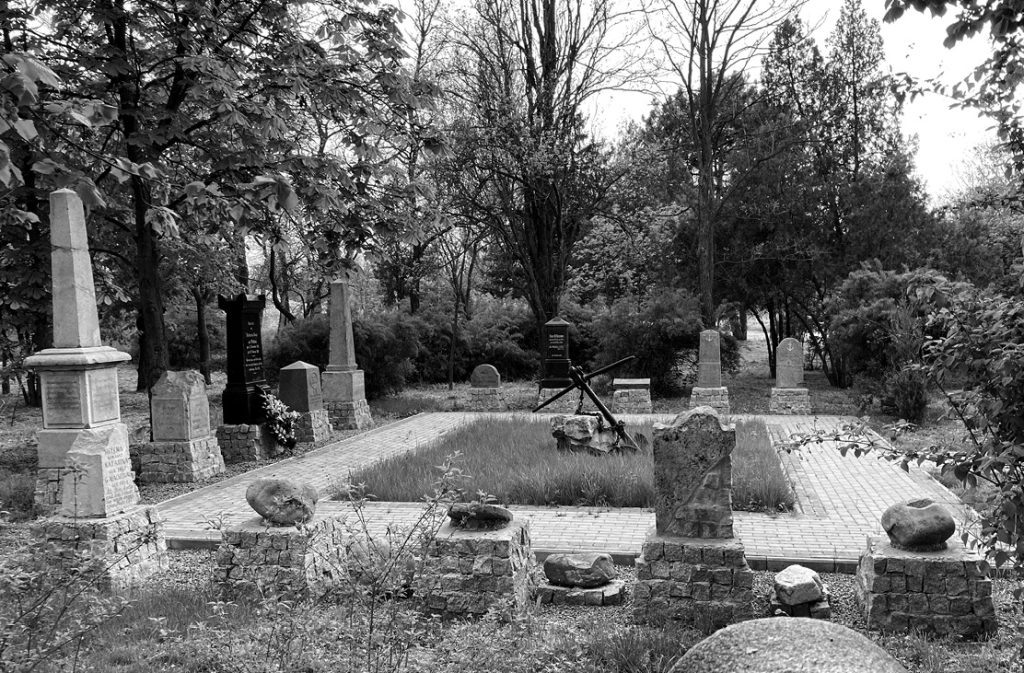
The restoration of the fifteen stones was completed in the spring of 2021 and the dedication of the memorial occurred on June 24, 2021. Two years of hard work were celebrated on that day. Speeches were made by Max and many of the invited guests. What was once only a dream by Max had turned into reality on that day. It was obvious that even early in his career, Max had already made a great contribution to the revival of the history of the Mennonites of Chortitza.
Hoeppner Headstone and Gravesite
The Chortitza cemetery gravestone project was not Max’s only successful endeavour. In 2020, he embarked on another Mennonite gravestone project, this one involving Jacob Hoeppner.
Jacob Hoeppner and Johann Bartsch were the two delegates sent by the Mennonites of Prussia in 1786 to seek possible immigration opportunities in what was then called New Russia. As a result of their journey and negotiations with tsarist officials, 228 Mennonite families migrated to New Russia in 1789. This led to the establishment of the Chortitza Mennonite settlement, located in what is now the Zaporizhzhia region.
In 1890, to honour the two delegates on the centenary of the migration from Prussia to the Ukrainian lands of imperial Russia, granite obelisks were erected on the graves of Hoeppner and Bartsch.
Max learned that, in 1973, Jacob Hoeppner’s memorial monument, along with two Hoeppner headstones, had been purchased and taken to Steinbach, Manitoba. The monument and headstones were then put on display at the Mennonite Heritage Village. The Hoeppner monument and headstones were originally located on Chortitza Island on land that had once belonged to Hoeppner. Buried at the site were Jacob Hoeppner, his wife Sara Dueck, their youngest son Jacob, and his wife Anna Brandt. Each couple’s headstone was engraved with the name of the husband on one side and the wife on the other.
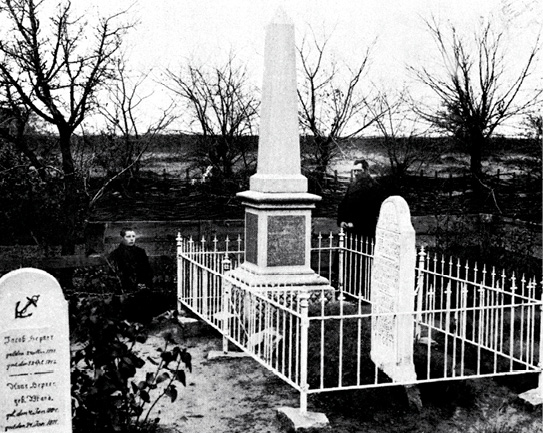
Max discovered that the gravesite in Ukraine was now abandoned and had no markers or landmarks. “I was very surprised to find out that the issue with the grave of the founder of the Mennonite colony on Khortytsia, as well as all other colonies in southern Ukraine, Jacob Hoeppner, was still not resolved,” wrote Max. “This came as a complete surprise to me. The reason why the graves were abandoned without headstones was unclear to me. Jacob Hoeppner was without any doubt a historical figure who had a great influence on the development of the Zaporizhzhia region. This is where our project began.”
Max, Dmitry Kobaliia, R. B. Kobaliya, S. G. Krivonosova, and M. A. Svydranya started the search for the gravesite in June 2020. Aided by old photographs, archival documents, and information from local residents, it was soon found.
During the months of June and July the gravesite was cleared of debris and brush. This led to the important discovery of the concrete base that was used for the monument. Using historical photographs of the gravesite and the location of the monument base, Max discovered where the original headstones had been placed.
Upon discussions with Max and Dmitry Kobaliia, head of the Department of Monument Protection and Archaeology at the KNR, a plan was formulated to create replicas of the original Hoeppner headstones. Both stones would then be placed at the gravesite along with a storyboard on the legacy of Jacob Hoeppner.
To ensure the headstones were exact replicas, Max obtained photographs and the dimensions of the headstones from Andrea Klassen, curator of the Mennonite Heritage Village.
In October 2020, Kobaliia made arrangements with a local quarry to create two headstones with the exact dimensions of the original stones. The stones were then inscribed with the text found on the original stones by Lyudmila Yeletskaya.
At the beginning of November, the replica headstones were secured with steel-enforced concrete bases and were placed in the positions of the original headstones. A storyboard with a narrative about the legacy of Jacob Hoeppner was later added to the gravesite.
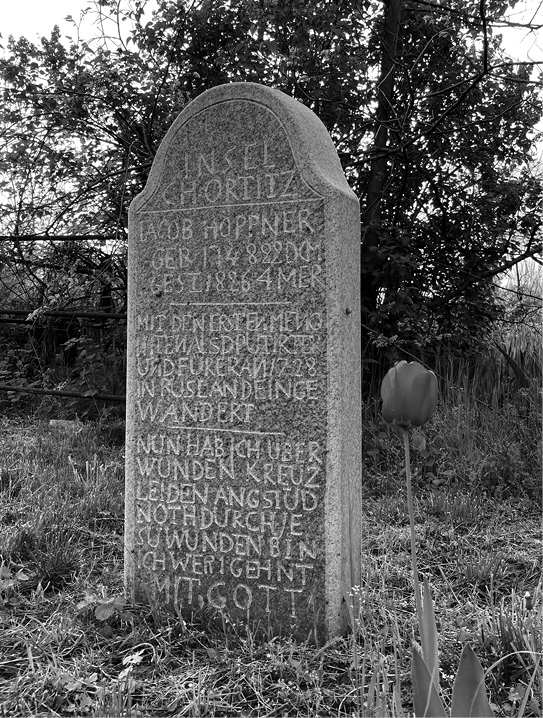
Max concluded, “We restored historical justice and returned the Hoeppners not only their tombstones, but also the respect they deserve.”
Searching for the Centennial Monument
In 1890, to commemorate the one hundredth anniversary of their settlement, the Chortitza Mennonites resolved to build a monument made of granite stones and have it placed in a prominent area of the village.
An announcement about the planned monument was published on page 2 of the June 11, 1890, edition of Die Mennonitische Rundschau: “To commemorate the 100-year anniversary of the establishment of the Chortitza Mennonite colony, the Mennonites in the government district of Jekaterinoslav will be erecting a granite monument in the village of Chortitza. The estimated cost of the monument will be 4–5 thousand rubles. The monument will be funded by donations from Mennonites.”
After the construction of the monument was completed, it was placed at the intersection of three streets in the village of Chortitza. The monument was constructed with twelve grey granite stones and featured an impressive towering obelisk.
The monument sat at its location relatively unscathed until 1938. In 1995, Johann Epp, the last Oberschulz (district mayor) of the Chortitza settlement, who was then living in Germany, provided his recollection of events surrounding the disappearance of the monument: “It was not soldiers who destroyed the monument; it was a group of workmen directed by the NKVD (KGB) in 1938.” Epp went on to say that after the monument was dismantled, it was buried in the courtyard of the Wallman residence.
During the Second World War, the German army occupied the village of Chortitza from 1941 until 1943. It is reported that during the occupation all the stones were located and the monument was reassembled. It is believed that after the Mennonites of Chortitza left with the retreating German army in 1943, the monument was again taken down by local authorities. From that time onward, no one was interested in discovering the fate of the monument until 2011.
This was one of the projects Max started working on early in his career. It was another mystery that he was determined to solve. A search for information from local and state archives was met with negative results. The only piece of information located by Max was a handwritten note in a book he found at a local library. The self-published book exploring the history of Upper Chortitza was written by a local historian. The note indicated that the monument was destroyed in 1950. Time passed with no leads or further information, but the fate of the monument stones was always top of mind for Max.
The search was reignited in 2021, when Max and a group of local citizens were inspired by a photo that was taken in 2004. The photograph, believed to be the monument base, was taken by Ms. Ella Federau, who was in Ukraine acting as an interpreter for a Mennonite mission group from Canada. The photograph was later published in the book Building on the Past by Rudy Friesen. In the black-and-white photo, the square stone, partially buried, was clearly visible and appeared to be situated in a wooded area in Upper Chortitza.
On March 11, after a search of an area approximately ninety metres from its original 1890 location, Max located the piece of the monument that had been photographed. It had been buried in a wooded area and had most likely been moved from its 2004 location. The granite piece was estimated to weigh approximately 1.8 tons. Two inscriptions were visible on the stone and were identified as “Zum Andenken” (In memory) and “первые поселенцы” (First settlers). A few days later, Max hired a truck with a crane and the piece was transported to the KNR property on Khortytsia Island. Upon further investigation by Max and discussions with historians from Canada, it was determined that this piece of the centennial monument was in fact one part of the three-piece upper section.
With this piece now safely stored at the KNR, the search for remaining sections of the monument became a priority for Max. It was his intention to continue the search for the remaining pieces. Sadly, the 2022 invasion of Ukraine prevented him from further searches. To date, no other pieces of the monument have been discovered.
Repression Files from the Great Terror
It didn’t take long for Max to become well known to European and North American Mennonites because of his work on the history of the Mennonites in Ukraine. Social media provided him with broad exposure and connections with Mennonite historians and people with Mennonite roots in Ukraine.
Along with searching for lost gravestones and other research projects, Max found time to visit state archives to retrieve NKVD police files for the relatives of Mennonites who were the victims of political repression.
The years 1937–1938 in the Soviet Union were a time when the authorities were mandated to seek out and arrest German spies and anti-Soviet elements. During this period, many men in Mennonite villages, considered to have German origins, were arrested, never to return home. For many years, and still to this day, many families have never learned the fate of their husbands, fathers, or grandfathers. These missing men were classified as exiled and were presumed to have been taken to labour camps, where they disappeared.
In 2015, the Ukrainian government enacted legislation that opened the NKVD/KGB files for review by relatives and scholars. This opened the door for families to finally discover the fate of their family members.
Max had a personal connection to the repressed, as his own great-grandfather, Klim Ivanovych Shtatsky, was sent to a labour camp for three years in 1929. The Shtatsky family was living in the village of Mykhailivka at the time Klim was arrested. After his arrest the family was expelled from the village and subsequently moved to Chortitza. After completing his sentence, Klim joined his family in Chortitza.
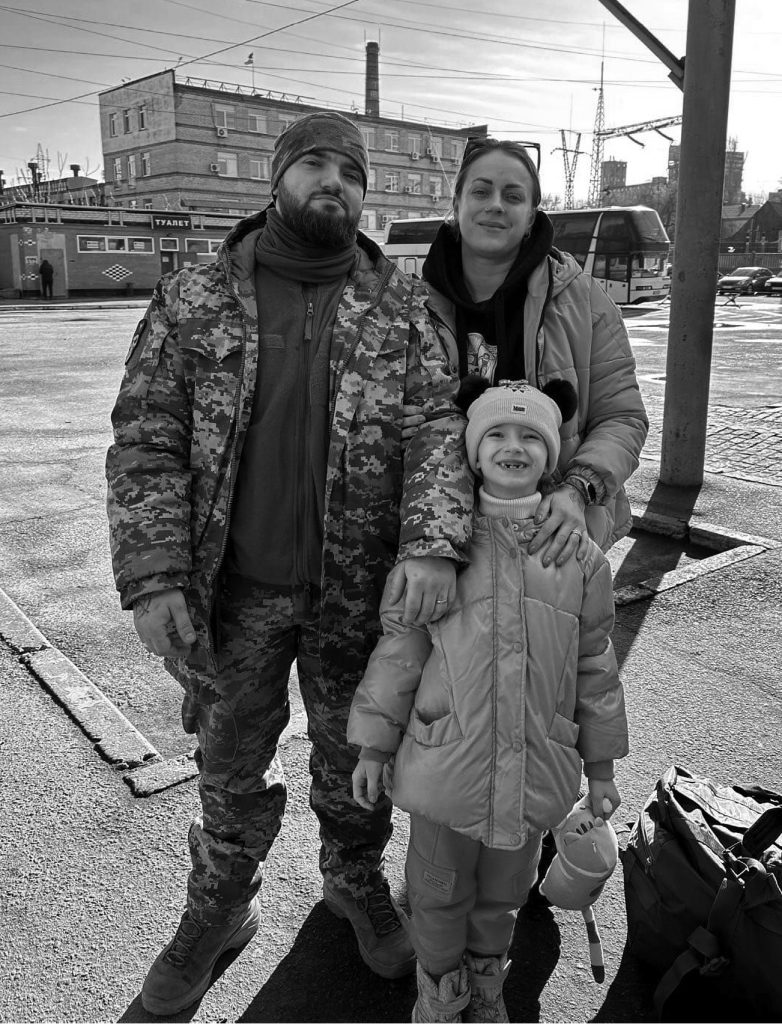
With his knowledge of the period and experience in the archives, Max helped many Mennonite families of the repressed discover their fates. These are the words from one of those family members Max assisted by obtaining the files of her grandfather: “Two days ago, I got my grandfather’s death certificate from Max Shtatsky. My hands were shaking and tears were streaming down my face. I never expected this to hit me so emotionally. My family, especially Grandma, who had been dead for thirty years, had suspected for many years that her husband was shot. But reading in black-and-white that his body is somewhere in Melitopol-Zaporizhzhia makes me want to do something to erect a memorial to him. Of course, I really hope and believe I will meet my grandfather in heaven someday.”
Legacy
There is no doubt that Max Shtatsky made a profound contribution to uncovering the history of the Mennonites in Ukraine. He had the boundless energy to tackle not only decades-old mysteries but the physical strength needed to find long-forgotten Mennonite landmarks and objects. I believe that, had he survived the war, he would have continued to uncover the past of his long-forgotten neighbours. Max deserves to be recognized for all his work on Mennonite history and, as a result, I bestow upon him posthumously the title of Honorary Mennonite.
Rest in peace, my friend.
Werner Toews was the chairperson of the Chortitza Headstone Project and worked closely with Max Shtatsky on the project for over two years. He has published articles in several publications on Russian Mennonite themes and is the author of the book Sketches from Siberia: The Life of Jacob D. Sudermann.
